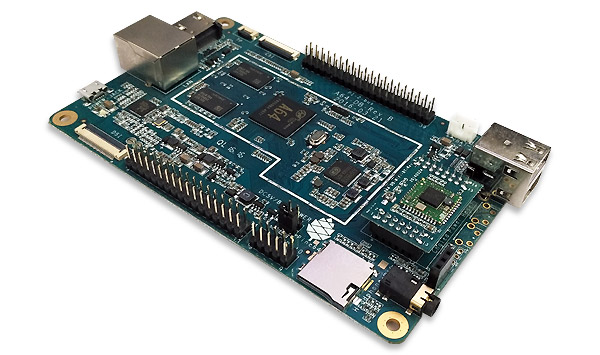Difference between revisions of "PINE A64"
| Line 16: | Line 16: | ||
[[Pine_A64_Software_Release#Fedora_Base_Image|'''Fedora Base Image''']] | [[Pine_A64_Software_Release#Fedora_Base_Image|'''Fedora Base Image''']] | ||
[[Pine_A64_Software_Release#openSUSE|'''openSUSE''']] | |||
[[Pine_A64_Software_Release#OpenWRT|'''OpenWRT''']] | [[Pine_A64_Software_Release#OpenWRT|'''OpenWRT''']] | ||
Revision as of 22:02, 28 December 2020
Software and OS Image Downloads
PINE A64(+)
Note that PINE A64(+) OS images are not compatible with PINE A64-LTS due to its LPDDR3 memory configuration.
For PINE A64-LTS OS image downloads please refer to the SoPine and Pine64-LTS Section
Under PINE A64(+) Software and OS Image Download Section you will find a complete list of currently supported Operating System images that work with the PINE A64(+) as well as other related software.
The list includes OS images and descriptions of:
Volumio 2 Digital Audio Player
Quick Links to OS Images Build Sources
Some of the provided OS images are still in beta or nightly build and only fit for testing purposes. These images ought to be avoided for normal usage - use them at your own risk
- longsleep BSP Linux
- ayufan Linux
- ayufan Android 7.1 | ayufan Android 6.0 | ayufan Android 5.1
- openSUSE
- Armbian
- Arch Linux XFCE by anarsoul
- Fedora
- Gentoo
- Q4OS
- OpenWRT
- DietPi
- openHAB 2
- Volumio Digital Audio Player | External DAC Forum Thread
- FalconGate
- motionEyeOS
- Bliss OS
- OpenMediaVault
Accessories Step-by-Step Guides
Under 'Guides for PINE A64(+) accessories' you can find instructions and guides pertaining to:
- Enclosures
- Bluetooth and WiFi module
- Real Time Clock (RTC) battery
- Real Time Clock (RTC) battery holder
- First and third party cases
- Featured 3D printed cases (and more).
SoC and Memory Specification
- Based on Allwinner A64
CPU Architecture
- Quad-core ARM Cortex-A53 Processor@1152Mhz
- A power-efficient ARM v8 architecture
- 64 and 32bit execution states for scalable high performance
- Support NEON Advanced SIMD (Single Instruction Multiple Data) instruction for acceleration of media and signal processing function
- Support Large Physical Address Extensions(LPAE)
- VFPv4 Floating Point Unit
- 32KB L1 Instruction cache and 32KB L1 Data cache
- 512KB L2 cache
GPU Architecture
- ARM Mali400MP2 Dual-core GPU
- Support OpenGL ES 2.0 and OpenVG 1.1 standard
System Memory
- RAM Memory Variants: 512MB, 1GB and 2GB DDR3.
- Storage Memory: PINE A64 boards do not have built-in Flash memory but use bootable microSD Cards or USB attached storage.
Board Features
Video
- Digital Video Port (Type A - full)
Audio
- 3.5mm stereo earphone/microphone plug
Network
- 10/100/1000Mbps Ethernet(PINE A64+ version), 10/100Mbps Ethernet(PINE A64 version)
- WiFi 802.11 b/g/n with Bluetooth 4.0 (optional)
Storage
- microSD - bootable, support SDHC and SDXC, storage up to 256GB
- USB - 2 USB2.0 Host port
Expansion Ports
- DSI - Display Serial Interface, 4 lanes MiPi, up to 1080P
- CSI - CMOS Camera Interface up to 5 mega pixel
- TP - Touch Panel Port, SPI with interrupt
- RTC - Real Time Clock Battery Connector
- VBAT - Lithium Battery Connector with temperature sensor input
- Wifi/BT Module Header - SDIO 3.0 and UART
- 2x20 pins "Pi2" GPIO Header
- 2x17 pins "Euler" GPIO Header
- 2x5 pins "EXP" Console Header
Pine A64 Board Information, Schematics and Certifications
- Board Dimensions: 133mm x 80mm x 19mm
- Input Power: DC 5V @ 2A, 3.7V Li-Ion battery connector, microUSB connector, Euler connector
- Power Consumption: 2.5W
- PINE A64 Connector Layout @courtesy of norm24
- PINE A64 Heat Sink Location @courtesy of norm24
- PINE A64 Connector List
- PINE A64 Pi-2/Eular/Ext Bus/Wifi Bus Connector Pin Assignment (Updated 15/Feb/2016)
- Board Model Comparison
- PINE A64 Board Schematic:
- PINE A64 Stereo Audio Dac Board Schematic
- PINE A64 Certifications:
- Disclaimer: Please note that PINE64 SBC is not a "final" product and in general certification is not necessary. However, PINE64 still submit the SBC for FCC, CE, and ROHS certifications and obtain the certificates to prove that the SBC board can pass the testing. Please note, a final commercial product needs to perform its own testing and obtain its own certificate.
- PINE A64 FCC Certificate
- PINE A64 CE Certificate
- PINE A64 RoHS Certificate
Datasheets for Components and Peripherals
- Allwinner A64 SoC information:
- X-Powers AXP803 PMU (Power Management Unit) information:
- PINE A64, PINE A64+ and SOPINE Related:
- 5MPixel CMOS Camera module information:
- LCD Touch Screen Panel information:
- Lithium Battery information:
- Ethernet PHY information:
- Wifi/BT module information:
- Enclosure information:
- Connector information:
- Remote control button mapping
Pine A64 POT
Other Resources
- Linux Sunxi Wiki page on PINE A64
- PINE A64 Linux build scripts, tools and instructions by Longsleep
- PINE A64 Linux image by Longsleep
- PINE A64 Linux Github by ayufan
- PINE A64 Android Github by ayufan
- Armbian's PINE A64 Page
- Collection of scripts to set up a minimal Xenial 14.04.3 / Debian 8 Jessie root filesystem Contributed By Uli Middelberg
- Linux Image created by Andre Przywara
- PINE A64 with HypriotOS by Dieter and Govinda
- H2testw 1.4 – Gold Standard In Detecting USB Counterfeit Drives
- F3 - an alternative to h2testw
- Benchmarking The Low-Cost PINE 64+ ARM Single Board Computer by Michael Larabel
- A series of Youtube video on PINE A64 Developers Board by Michael Larson
- PINE64 Quick Start Guide (with Gotchas)
- Shrinking images on Linux by FrozenCow
- FFmpeg Hardware encoder Cedrus264 on Linux by avafinger

